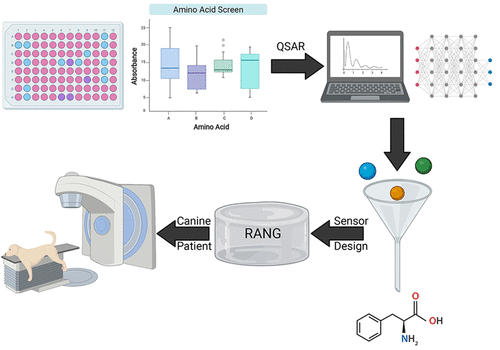当前位置:
X-MOL 学术
›
Bioconjugate Chem.
›
论文详情
Our official English website, www.x-mol.net, welcomes your
feedback! (Note: you will need to create a separate account there.)
Radiation-Responsive Amino Acid Nanosensor Gel (RANG) for Radiotherapy Monitoring and Trauma Care
Bioconjugate Chemistry ( IF 4.0 ) Pub Date : 2021-08-13 , DOI: 10.1021/acs.bioconjchem.1c00262 Karthik Pushpavanam 1 , Subhadeep Dutta 2 , Ni Zhang 3 , Tyree Ratcliff 3 , Tomasz Bista 4 , Thaddeus Sokolowski 4 , Eric Boshoven 5 , Stephen Sapareto 4 , Curt M Breneman 3 , Kaushal Rege 1
Bioconjugate Chemistry ( IF 4.0 ) Pub Date : 2021-08-13 , DOI: 10.1021/acs.bioconjchem.1c00262 Karthik Pushpavanam 1 , Subhadeep Dutta 2 , Ni Zhang 3 , Tyree Ratcliff 3 , Tomasz Bista 4 , Thaddeus Sokolowski 4 , Eric Boshoven 5 , Stephen Sapareto 4 , Curt M Breneman 3 , Kaushal Rege 1
Affiliation

|
Accurate detection of doses is critical for the development of effective countermeasures and patient stratification strategies in cases of accidental exposure to ionizing radiation. Existing detection devices are limited by high fabrication costs, long processing times, need for sophisticated detection systems, and/or loss of readout signal over time, particularly in complex environments. Here, we describe fundamental studies on amino acid-facilitated templating of gold nanoparticles following exposure to ionizing radiation as a new colorimetric approach for radiation detection. Tryptophan demonstrated spontaneous nanoparticle formation, and parallel screening of a library of amino acids and related compounds led to the identification of lead candidates, including phenylalanine, which demonstrated an increase in absorbance at wavelengths typical of gold nanoparticles in the presence of ionizing radiation (X-rays). Evaluation of screening, i.e., absorbance data, in concert with chemical informatics modeling led to the elucidation of physicochemical properties, particularly polarizable regions and partial charges, that governed nanoparticle formation propensities upon exposure of amino acids to ionizing radiation. NMR spectroscopy revealed key roles of amino and carboxy moieties in determining the nanoparticle formation propensity of phenylalanine, a lead amino acid from the screen. These findings were employed for fabricating radiation-responsive amino acid nanosensor gels (RANGs) based on phenylalanine and tryptophan, and efficacy of RANGs was demonstrated for predicting clinical doses of ionizing radiation in anthropomorphic thorax phantoms and in live canine patients undergoing radiotherapy. The use of biocompatible templating ligands (amino acids), rapid response, simplicity of fabrication, efficacy, ease of operation and detection, and long-lasting readout indicate several advantages of the RANG over existing detection systems for monitoring radiation in clinical radiotherapy, radiological emergencies, and trauma care.
中文翻译:

用于放射治疗监测和创伤护理的辐射响应氨基酸纳米传感器凝胶 (RANG)
准确检测剂量对于在意外暴露于电离辐射的情况下制定有效的对策和患者分层策略至关重要。现有的检测装置受到制造成本高、处理时间长、需要复杂的检测系统和/或读出信号随着时间的推移而丢失的限制,特别是在复杂的环境中。在这里,我们描述了暴露于电离辐射后氨基酸促进的金纳米粒子模板化的基础研究,作为辐射检测的新比色方法。色氨酸表现出自发的纳米颗粒形成,并且对氨基酸和相关化合物库的平行筛选导致了包括苯丙氨酸在内的主要候选物的鉴定,苯丙氨酸证明了在电离辐射存在下金纳米颗粒典型波长处的吸光度增加(X-射线)。对筛选(即吸光度数据)的评估与化学信息学模型相结合,阐明了理化性质,特别是可极化区域和部分电荷,它们控制着氨基酸暴露于电离辐射时纳米颗粒的形成倾向。核磁共振波谱揭示了氨基和羧基部分在确定苯丙氨酸(筛选中的一种先导氨基酸)纳米颗粒形成倾向中的关键作用。这些发现被用于制造基于苯丙氨酸和色氨酸的辐射响应氨基酸纳米传感器凝胶(RANG),并证明了 RANG 在预测拟人胸部模型和接受放射治疗的活体犬患者中电离辐射的临床剂量方面的功效。 生物相容性模板配体(氨基酸)的使用、快速响应、制造简单、功效、易于操作和检测以及持久读数表明 RANG 相对于现有检测系统在临床放射治疗、放射紧急情况下监测辐射方面具有多个优势和创伤护理。
更新日期:2021-09-15
中文翻译:

用于放射治疗监测和创伤护理的辐射响应氨基酸纳米传感器凝胶 (RANG)
准确检测剂量对于在意外暴露于电离辐射的情况下制定有效的对策和患者分层策略至关重要。现有的检测装置受到制造成本高、处理时间长、需要复杂的检测系统和/或读出信号随着时间的推移而丢失的限制,特别是在复杂的环境中。在这里,我们描述了暴露于电离辐射后氨基酸促进的金纳米粒子模板化的基础研究,作为辐射检测的新比色方法。色氨酸表现出自发的纳米颗粒形成,并且对氨基酸和相关化合物库的平行筛选导致了包括苯丙氨酸在内的主要候选物的鉴定,苯丙氨酸证明了在电离辐射存在下金纳米颗粒典型波长处的吸光度增加(X-射线)。对筛选(即吸光度数据)的评估与化学信息学模型相结合,阐明了理化性质,特别是可极化区域和部分电荷,它们控制着氨基酸暴露于电离辐射时纳米颗粒的形成倾向。核磁共振波谱揭示了氨基和羧基部分在确定苯丙氨酸(筛选中的一种先导氨基酸)纳米颗粒形成倾向中的关键作用。这些发现被用于制造基于苯丙氨酸和色氨酸的辐射响应氨基酸纳米传感器凝胶(RANG),并证明了 RANG 在预测拟人胸部模型和接受放射治疗的活体犬患者中电离辐射的临床剂量方面的功效。 生物相容性模板配体(氨基酸)的使用、快速响应、制造简单、功效、易于操作和检测以及持久读数表明 RANG 相对于现有检测系统在临床放射治疗、放射紧急情况下监测辐射方面具有多个优势和创伤护理。











































 京公网安备 11010802027423号
京公网安备 11010802027423号